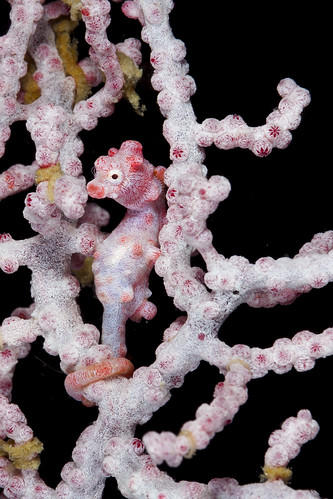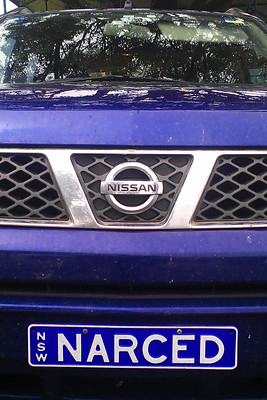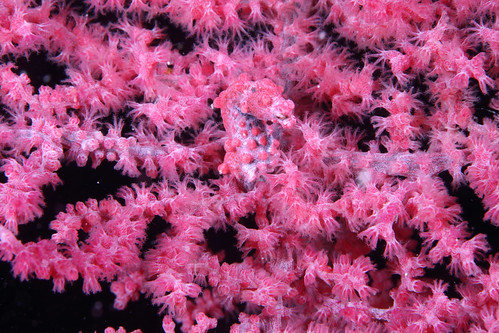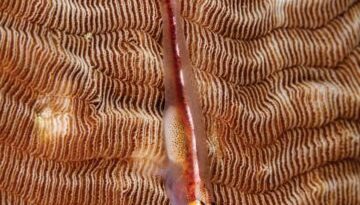Debunked: Flash Photography Kills Seahorses
An opinion which very often circulates on scuba diving and underwater photography web pages and social media forums is that photographing seahorses, especially the pygmy seahorse (Hippocampus bargibanti) with a strobe is highly detrimental to the animals and should be avoided. The strobes supposedly blind, stress or kill the seahorses. Taking pictures of a seahorse with a strobe is something a responsible diver doesn’t do.
Occasionally dive guides would forbid their divers to use strobes; underwater photo magazine would refuse to accept images of pygmy seahorses; photographers would proudly state in their image descriptions that they used no strobes or only took one strobed photograph of that seahorse. I am sure that in most cases, these acts are well intentioned. Some of it sounds a little bit like hyperbaric virtue signaling to me. So let’s look at the solid evidence for or against using strobes to photograph seahorses:
There is one excellent scientific paper by Dave Harasti & William Gladstone, and another excellent one by Marteen De Brauwer and colleagues which look at the issue in great detail. What is a scientific paper, in contrast to an article on a scuba diving we page, or a social media blog post? It’s a systematic study, with controls, with statistics, done and written up by scientists with advanced degrees and typically many years of experience in the field. Then, after these scientists write up their results, they send it to a scientific journal, where the paper is peer reviewed, assessed by scientific colleagues on its merits and overall quality. Not everything which ends up in a a peer-reviewed scientific journal is always true, and science evolves, meaning that occasionally concepts considered true 20 years ago are now considered outdated. But in general the chances for a peer reviewed paper being correct are much, much better compared to some dude’s opinion on some webpage. Think of peer-review as quality control, which can fail, but which will on average produce a much better outcome than in cases where quality control is lacking.
Seahorses in Australia
Dave Harasti and William Gladstone looked at the question “Does underwater flash photography affect the behaviour, movement and site persistence of seahorses?”. They studied Hippocampus whitei, a medium-sized seahorses species. They conducted their study in the Port Stephens estuary in New South Wales, the Australian state where the city of Sydney is also located (but the study site is far from Sydney). I dived in the area quite a bit, what a great piece of ocean. Here are my shots from Port Stevens:
The scientists observed 24 seahorses, split into 3 groups. The 3 groups were treated in the following ways: 1. flash photography, 2. handling and flash photography and 3. photography without flash, no handling. They then observed: Did the seahorses hide? Swim away? Move to a new place to hold on? Don’t react? They recorded their observations meticulously and did statistics on them.
There was a big difference between handling the seahorses and the other cases: the seahorses swam away and hid more often. There was no statistically significant difference between photography with and without a flash.
Yes, this study did not specifically look at the pygmy seahorse, but on a larger species. It could be that the eyes of pygmy seahorses are very different compared to the eyes of Hippocampus white, but it’s not likely. Eyes between animals in the same family are usually similar, unless the species differ significantly in how they use vision (active at night or during the day, for instance).
Fish and Flash
Marteen De Brauwer and colleagues investigated in general if flash photography is detrimental to benthic (bottom living) fishes. Their study is titled “Behavioural and pathomorphological impacts of flash photography on benthic fishes”. The scientists did field studies and checked in lab experiments if strobes altered the retinae of fishes. they tested this on several different seahorses, ghost pipefishes, and frogfishes.
To quote from their paper (my bold text):
“Our study showed that effects of photographic flashes are negligible and do not have stronger impacts than those caused solely by human presence. Photographic flashes did not cause changes in gross ocular and retinal anatomy of seahorses and did not alter feeding success.”
Hence: Flash photography does not kill/blind/terrorize seahorses. Neither does it do that to frogfishes.
What this does not mean: That you can go & be a hooligan underwater. That you don’t have to be careful with your buoyancy and with your camera setup touching the reef. Of course you have to be careful!
I might add, it’s a tad hypocritical to worry too much about disturbing a fish during a scuba dive, and then heading to the seafood restaurant post-dive, to eat a fish which someone else has killed for you. Killing is typically worse than shining light at. But that’s just my personal approach to the issue, I don’t hate you if you eat fish, of course.
Literature:




